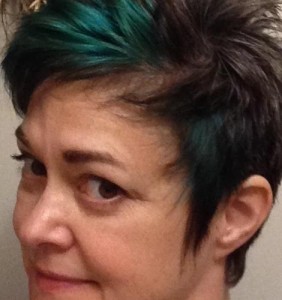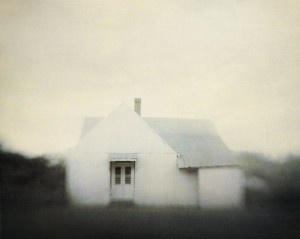Gary Short: Your poem “Those Who Once Lived There Return” appears in the “SPIRITS” issue of r.kv.r.y quarterly, and indeed there is a ghostly quality to the poem. I’ve noticed a sense of things and people absent but seemingly present in other of your poems. How would you describe the territory, both literal and metaphorical, that your poems inhabit? Do you think of your poems as haunted? What places do you write from?
Wendy Miles: I think about both concepts—territory and haunting—quite a bit. I’m interested in the reverberation of past events—memories, personal histories—and how objects are imbued with spirit. That’s one thing that draws me. When I talk about “Those Who Once Lived There Return,” another poem of mine called “Float” seems necessary in the conversation because in these two poems I feel enveloped by reverberation—while in a specific landscape. One reason I’m so pleased to have “Those Who Once Lived There Return” published in r.kv.r.y is that “Float” was also accepted, but I got Mary Akers’ e-mail the day after “Float” won the 2014 Patricia Dobler Award. So that poem doesn’t appear here, but it was the breakthrough I needed in order for “Those Who” to exist. When I finished “Float” I was in residency at Virginia Center for the Creative Arts (one of my favorite places). I was in my room for the night, on my little twin bed. I had the last few lines—which contain the word “love”—and I remember deleting the second “love” and then saying to myself, No, this poem is love. And I put the “love” right back in there.
The next day I printed it off and drove it to the post office, which was the postmark deadline. And it won! The marvelous poet Yona Harvey picked it! She said she found in it “delight.” To my mind, she found the love. Not a cliché but the real source that insisted its way into that poem. And for me that poem is also a place, and since its creation the only time I’ve gotten back to that place is with “Those Who.” It feels sort of magical, really, though I risk credibility saying a word like that, don’t I? In any case, Mary was kind enough to create the “Spirits” issue upon acceptance of “Those Who Once Lived There Return.” My initial thought was, These aren’t spirits but ghosts. I told myself, It’s just semantics, Wendy. But maybe not. To me, the word “spirit” connotes something happier. I was spirited away, She shows great spirit, that kind of thing. And ghosts, well, ghosts linger, don’t they? Ghosts drape themselves across furniture in empty rooms. If my poems are haunted, then hopefully they are also haunting. Does one condition create the other? Hopefully.
I often incorporate “true” events into my poems—in ways that reinterpret and shift and resettle the events—in different places, rooms, pastures, abandoned houses, yards, and so on. My mother told me once about a cat being lifted off the ground—carried away—by a hawk. And you can see what happened to that little story in the poem. It got shrouded in light and magic and it settled here. Speaking of light and magic, I just love the accompanying artwork by Dawn Surratt.
GS: You had a discussion on the NPR affiliated show Prosody last year. The interviewer, poet Jan Beatty, talked about leaping language and images as an evocative force in your poems. Could you could talk more about the notion of leaps in your poems?
WM: By recognizing “Float,” Yona Harvey gave me such a gift. By featuring me on Prosody, Jan Beatty gave me a gift as well. These are both wonderful, powerful women and poets—they know the depth and breadth of such recognition and encouragement—especially for women over the age of forty. The interview wasn’t rehearsed, and when Jan mentioned poetic leaps, I thought, Wow. So this is what it means to have paid some dues. For some time I’d been trying to move away from straight narrative into a more associative type of poem, and any gains I’ve made have been long sought and hard won.
About nine years ago I began to think of some poems as already existing—as sort of hovering out there in all their beauty and insistence—with my task being to puzzle them out, to put together scenes, dialogue, bits, moments, memories that I already recognized as “poem-ly” or “poem-ish”—to link them in ways that brought out their best features. Now that I think about it, it’s very visual, each time like making a still life. And it’s intuitive. I try to balance reading other writers and studying craft with my own intuition. I don’t think I’ll ever feel I’ve paid enough in “dues.” I’m not that confident. But the poems are confident. Does that even make sense? Yes. Of course it does.
GS: What are you working on now? You mentioned some self-portraits. Would you talk about that?
WM: The self-portraits. Yes. It seems I’m doing a series of them. I’m not sure how many there will be, and I didn’t set out with a series in mind. The first one sounded fun to try, and the result enticed me so much that I did another and another and so on. They feel like a natural progression from the work I’ve been doing with atmosphere. So I place a woman—or a girl—in a setting. There’s a bit of a Hansel and Gretel echo to me, but safer. The female’s perspective in these poems is at turns playful, curious, lonely, but her sense of “knowing” is always substantial. Portraits are usually as much about the environment surrounding the figure as the figure herself. Anyway, that’s what I’m up to now, and I’ll see where the poems go—where the figures want to dwell. I’ve joked, saying, Who do I think I am—Frieda Kahlo? But we know, don’t we, that if we’re lucky, a figure observed over time discloses some secrets. If we’re even luckier, with each look, that same figure also entices by holding things back.
Gary Short is the author of three poetry collections: Theory of Twilight, Flying Over Sonny Liston (which won the Western States Book Award), and 10 Moons and 13 Horses. He has been a Stegner fellow at Stanford and a fellow at the Fine Arts Work Center in Provincetown. He has received a Pushcart Prize and a fellowship from the National Endowment for the Arts. Gary teaches fall semesters at the University of Mississippi and has a home in Panajachel, Guatemala.



Pingback: “Those Who Once Lived There Return” by Wendy Miles | Rkvry Quarterly Literary Journal